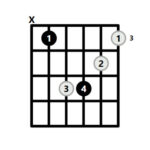Guitar tablature, commonly known as “guitar tabs,” is a revolutionary system of musical notation that makes learning guitar accessible to everyone, especially beginners. It’s a straightforward way to understand how to play your favorite songs without needing to decipher traditional music notation. Guitar tabs and standard notation share some similarities, indicating notes, rhythm, and techniques. However, guitar tabs offer a significant advantage, particularly for guitarists: they visually represent the guitar fretboard, showing you exactly where to place your fingers to play each note.
This is incredibly helpful because the guitar fretboard allows you to play the same note in multiple locations. Learning how to Read A Guitar Tab unlocks a fast track to playing guitar, bypassing the often daunting task of learning standard musical notation.
At guitarplayers.net, we believe in empowering aspiring guitarists with the most effective learning tools. That’s why we focus on how to read guitar tablature. Guitar tabs are versatile, displaying both chords and single notes, making them an efficient method for learning songs quickly. The beauty of guitar tabs lies in their simplicity; you don’t need prior musical knowledge beyond understanding the strings and frets on your guitar to start reading them.
If you’re eager to discover the world of guitar tabs and how they can accelerate your guitar learning journey, you’ve come to the right place. Let’s dive in and explore the essentials of reading guitar tabs.
What Exactly Are Guitar Tabs?
Guitar tablature is a visual representation of music specifically designed for guitar. A standard guitar tab is composed of six horizontal lines, each representing one of the six strings of a guitar. To read a guitar tab, you interpret it from top to bottom. The topmost line symbolizes the high E string (the thinnest string), followed by lines for the B, G, D, A, and low E strings (the thickest string).
This arrangement mirrors how you see the strings when you look down at your guitar in playing position. Think of guitar tablature as your personal roadmap to musical fluency on the guitar, providing the most direct route to learning songs you love.
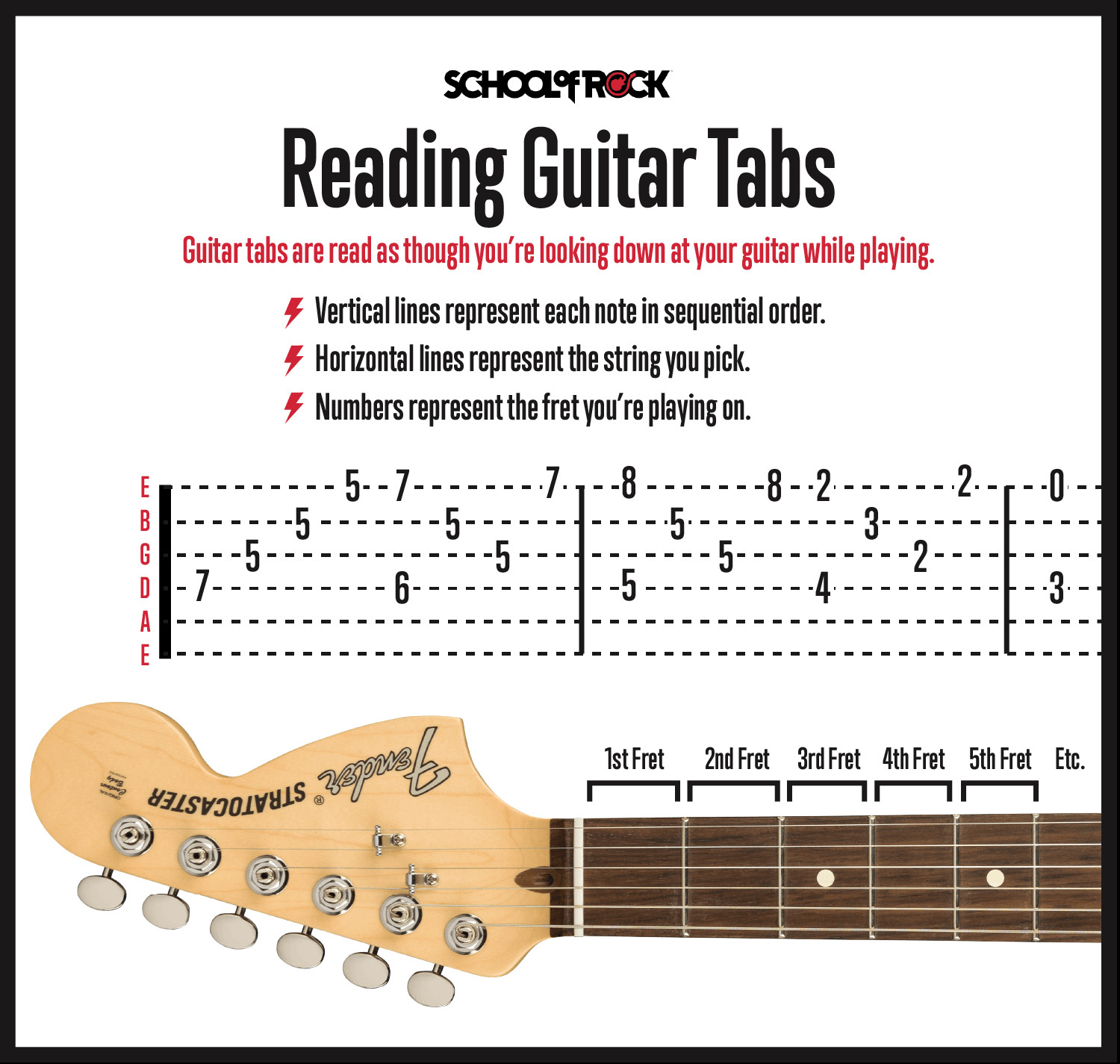 Reading guitar tabs
Reading guitar tabs
Within the guitar tab, you’ll encounter numbers on these lines. These numbers correspond to the frets on your guitar’s fretboard – the metal strips running along the neck. Frets are numbered starting from 0 at the nut (closest to the headstock) up to 24 or beyond, depending on your guitar.
A ‘0’ on a string indicates playing that string “open,” meaning you pluck the string without pressing down on any fret with your fretting hand. A ‘1’ signifies playing the string at the first fret, ‘2’ at the second fret, and so on. Understanding this numbering system is fundamental when learning how to read guitar tabs: each number directly translates to a fret position.
 Play Button
Play Button
Decoding Guitar Tabs: How to Read Them Effectively
Guitar tablature is read from left to right, just like standard written text. The notes are presented in the order they are played in the song. When you see numbers stacked vertically in a tab, it signifies a chord. A chord is played by strumming all the indicated strings simultaneously. For beginners, guitar tab notation is often more intuitive than standard notation because it explicitly shows you which notes form the chord and, crucially, where to find them on the guitar fretboard.
Essential Knowledge for Reading Guitar Tabs
To successfully read guitar tabs, beginners should first familiarize themselves with the names and order of the 6 guitar strings and the layout of the frets. This foundational knowledge enables you to quickly locate the correct notes on your guitar as indicated by the tab.
Understanding the Tab Staff
The guitar tab staff may look similar to the staff used in traditional music notation, but there’s a key difference. In guitar tabs, the lines of the staff represent the 6 guitar strings, not musical pitches as in standard notation.
The top line always represents the high E string, and the bottom line the low E string. This direct string-to-line correspondence is what makes learning how to read guitar tabs so beginner-friendly. To further avoid confusion, a tab staff is typically labeled “TAB.”
Exploring Guitar Frets
Guitar frets, the thin metal strips across the fretboard, are essential to playing different notes on the guitar.
Most guitars feature between 19 and 24 frets. Each fret represents a semitone or half step in musical pitch. Within each octave, there are 12 semitones (or frets). To help navigate the fretboard, guitars usually have fret markers—inlays on the side of the neck or fretboard itself—typically located at the 3rd, 5th, 7th, 9th, and 12th frets. These markers serve as visual guides for quickly finding fret positions.
Remember, in guitar tabs, numbers indicate fretted notes, while ‘0’ denotes an open string. Playing an open string simply means plucking or picking the string without fretting any note, allowing it to ring freely.
Interpreting Guitar Tab Chords
Guitar chords in tabs don’t have special symbols but are easily recognizable by their vertical arrangement. When multiple numbers are aligned vertically in a tab, they are intended to be played together as a chord. If a chord is arpeggiated (played one note at a time instead of strummed), it will be represented as a sequence of single notes in the tab, even though you are still technically playing the notes of a chord.
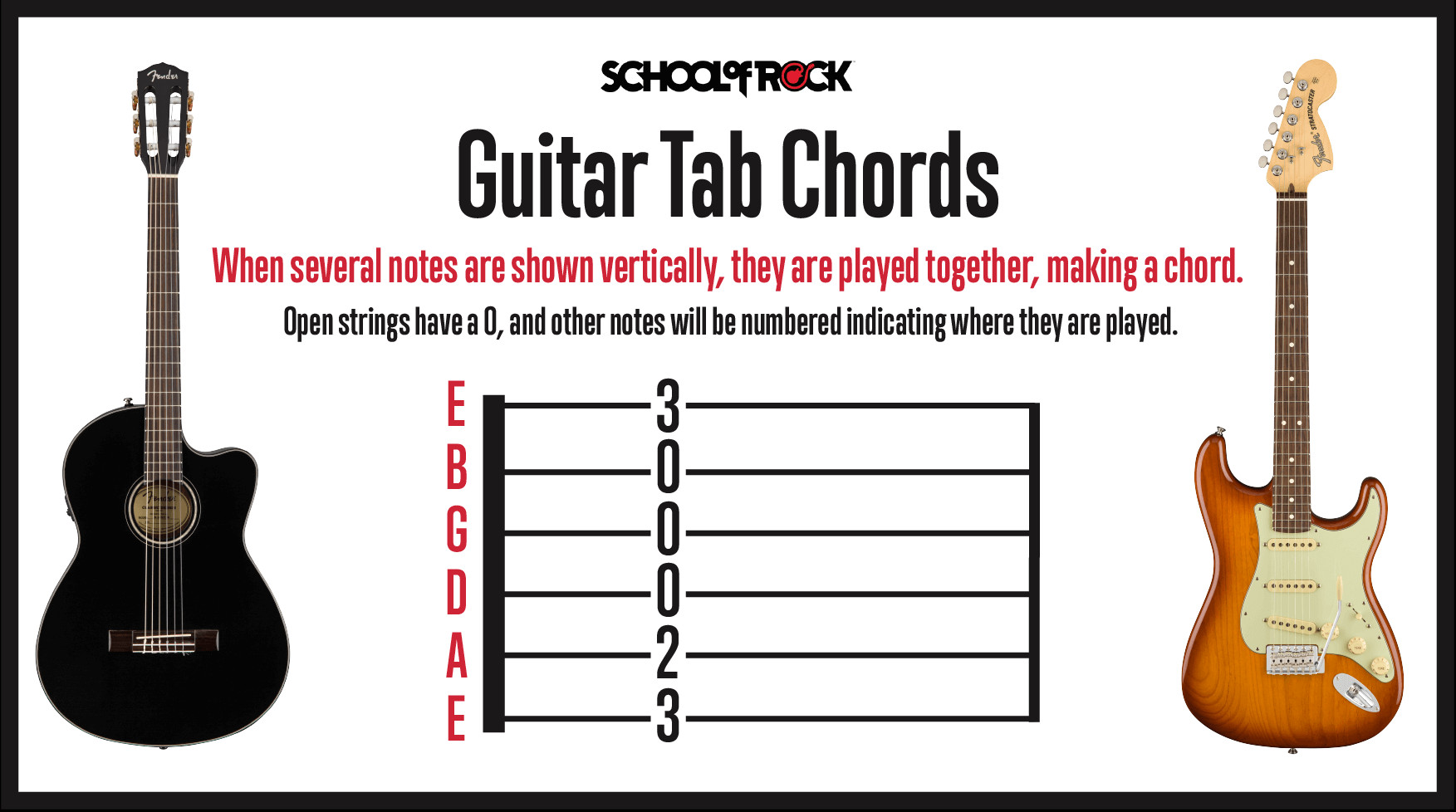 How to read guitar tab chords
How to read guitar tab chords
Recognizing Guitar Tab Riffs
Many rock and popular songs are built around “riffs”—short, repeated musical phrases. Riffs often combine single notes and partial chords, such as power chords. When reading guitar tabs for riffs, the same basic principle applies: vertically aligned notes are played together, while notes written horizontally are played sequentially. This consistency makes learning riffs from tabs straightforward.
Guitar Tabs vs. Chord Charts: Understanding the Difference
Guitar tabs and chord charts serve different but complementary purposes. A chord chart is a visual diagram showing you where to place your fingers on the fretboard to form a specific chord. Chord charts may also include finger numbers to guide your hand positioning. Chord charts are often placed above song lyrics to indicate chord changes as you sing or play along.
Chord charts typically only show the root chords, consisting of 3 or 4 unique notes. However, a full guitar arrangement may include additional single notes, notes outside the basic chord, or arpeggios, which chord charts don’t detail. Therefore, chord charts are frequently used alongside guitar tabs to give beginner guitarists a foundational understanding of chord progressions while tabs provide the nuanced details needed to play a song accurately.
Fingers and Numbers in Tabs and Charts
While guitar tabs use numbers to indicate frets, chord charts sometimes use a numbering system to represent fingers of the fretting hand. In chord charts, the index finger is typically 1, the middle finger 2, ring finger 3, and pinky finger 4.
It’s important not to confuse these finger numbers in chord charts with the fret numbers in guitar tabs. Tabs focus on fret positions, not finger placement, offering flexibility in how you finger a particular passage. Chord charts, on the other hand, may guide finger placement for basic chords. Easy guitar tabs sometimes incorporate chord charts to assist beginners with hand positioning for chord shapes.
Experience Live Guitar Performance
Our guitar programs are led by experienced, performing musicians who are passionate about teaching. We provide a supportive environment for all skill levels, encouraging students to develop their abilities and perform live on stage.
Guitar Tab Symbols: Beyond Numbers and Lines
Beyond lines and numbers, guitar tabs use symbols to represent various guitar techniques. Understanding these symbols is crucial for accurately interpreting tabs and making your playing sound authentic.
Before you begin playing from a tab, always ensure your guitar is properly tuned. Playing with an out-of-tune guitar will not produce the desired sound, regardless of how accurately you read the tab.
Muting Guitar Notes: Adding Dynamics to Your Playing
Muting is a vital technique, especially in genres like rock, metal, punk, and alternative. It adds character and dynamic variation to music.
Mastering Guitar Muting Techniques
Muting can be achieved with either your picking or fretting hand, or a combination of both. It’s a technique that adds polish and expressiveness to your playing. Many songs use muting in verses to create contrast with the chorus or hook, which might be played without muting.
Experienced guitarists often use muting intuitively to control unwanted noise and feedback, especially at higher volumes.
Palm Muting Technique in Guitar Tabs
Palm muting is a frequently used technique in rock guitar. It involves resting the palm of your picking hand lightly on the strings near the bridge while picking. Heavy palm muting creates a tight, percussive sound, whereas lighter palm muting allows notes to ring out slightly more. In guitar tabs, palm muting is usually indicated by “P.M.” above the section where it should be applied.
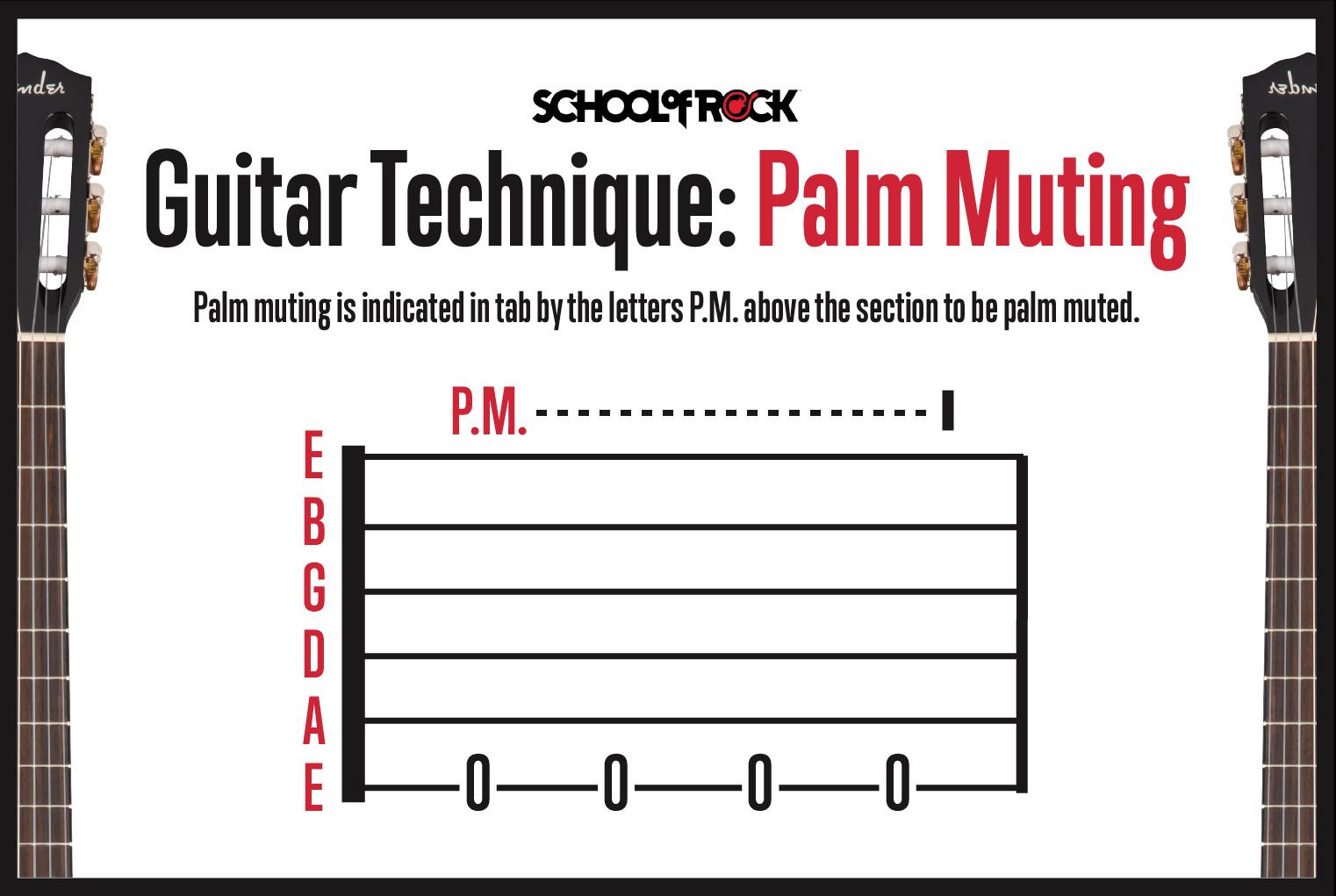 Guitar technique palm muting
Guitar technique palm muting
Muted Notes Technique in Guitar Tabs
Muted notes are different from palm muting and are achieved using the fretting hand. In tabs, muted notes are still picked, but the fretting hand only lightly touches the strings, preventing them from ringing out clearly. Muted notes are represented by an “X” in the tab where a fret number would typically appear.
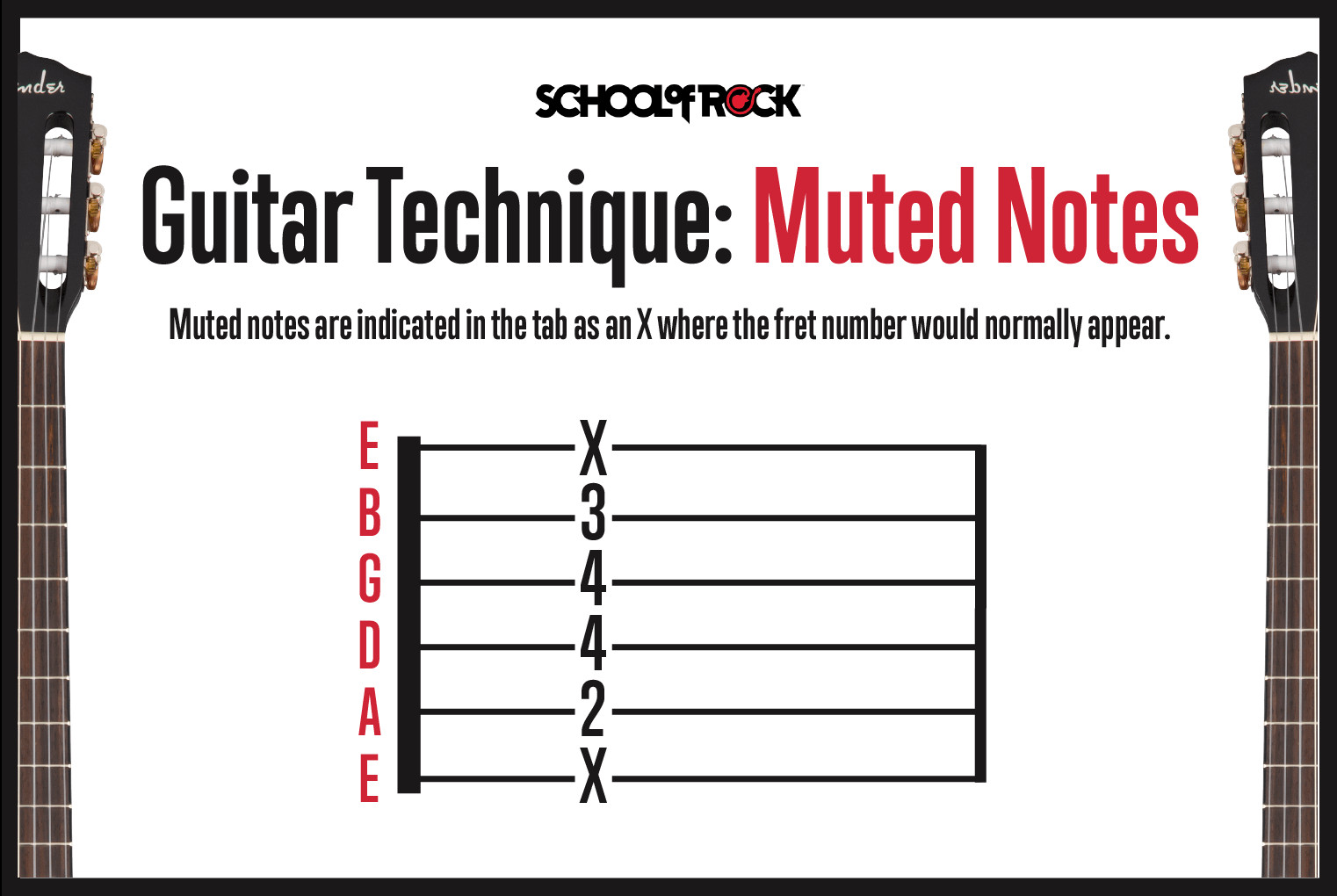 Guitar technique muted notes
Guitar technique muted notes
Bending Guitar Strings: Adding Vocal Expression
String bending is a technique that adds an expressive, vocal-like quality to guitar playing by altering the pitch of a note. In guitar tabs, bends are indicated by a curved arrow above the note. The arrow may specify a bend of a ½ step (one semitone) or a full step (two semitones), indicating the target pitch.
How to Execute String Bends
String bending involves pushing or pulling the string sideways across the fretboard, rather than pressing straight down. For most strings (except the low E), you typically push upwards towards the ceiling. The low E string is usually bent downwards towards the floor. The key to a good bend is applying smooth, consistent pressure.
String Bending Technique in Guitar Tabs
Most bends are performed using 2 or 3 fingers for added strength and control. The “main” fretting finger (often the ring finger) does the bending, while the middle and index fingers provide support. This technique results in smoother bends and better pitch control.
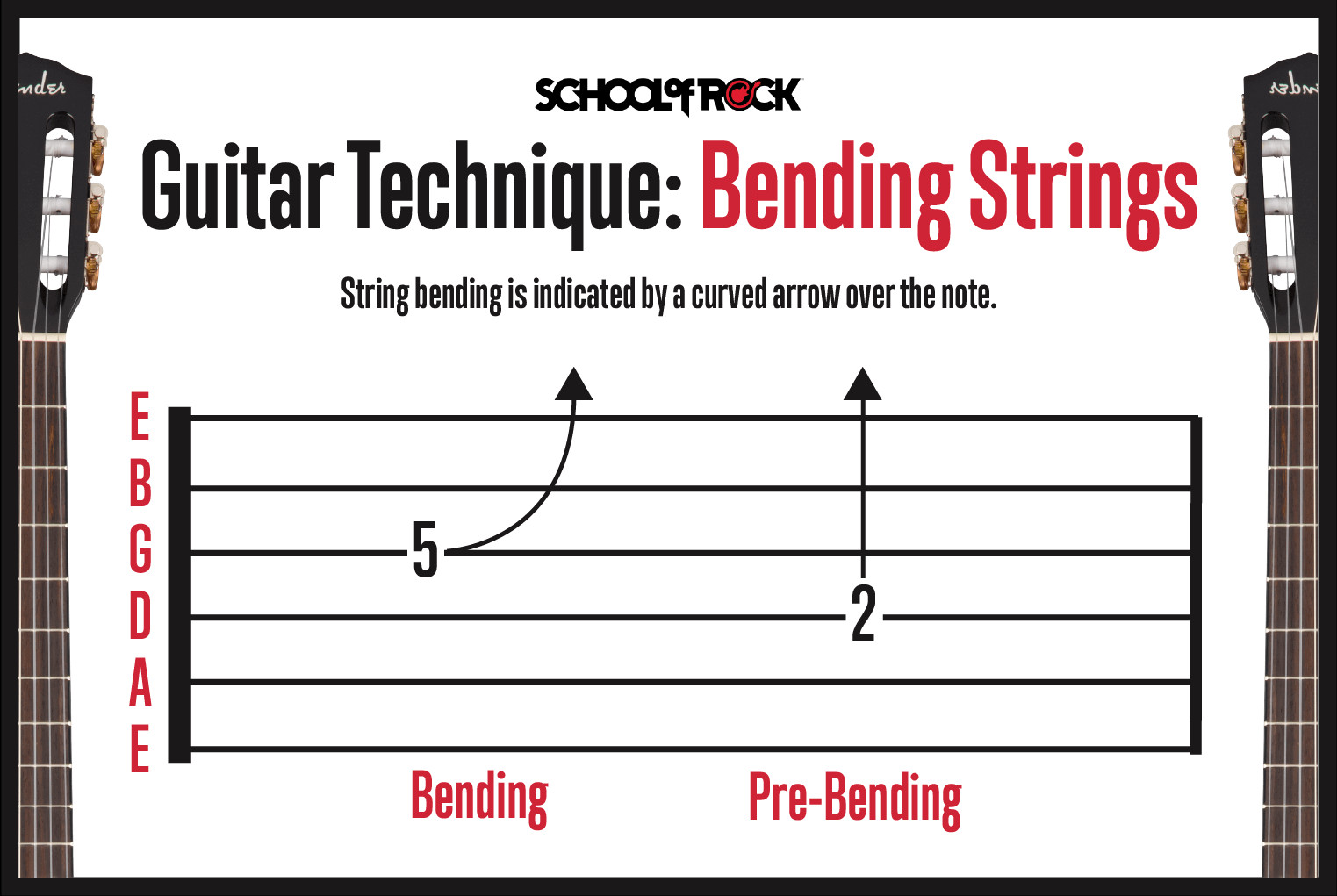 Guitar technique bending strings
Guitar technique bending strings
Pre-bending Guitar Strings in Tabs
Beginners learning how to read tabs may also encounter “pre-bends.” A pre-bend involves bending a string to a target pitch before picking it, then picking the pre-bent note, and sometimes releasing the bend back to the original pitch. Pre-bends are shown in tabs with an upward arrow indicating the bend amount (full, ½, etc.), followed by a curved arrow downwards if the bend is released. Pre-bent notes may return to the original note or bend further to another target pitch.
Sliding Guitar Notes: Smooth Transitions
Sliding is another essential technique for smoothly transitioning between notes. You can slide up to a higher note or down to a lower note. Unlike bending, sliding involves moving your fretting finger along the fretboard to the target fret while sustaining the note.
Slide Up Technique in Guitar Tabs
A slide up is shown in tabs by a line connecting the starting note to the ending note. If sliding to a higher note, the line may slant slightly upwards.
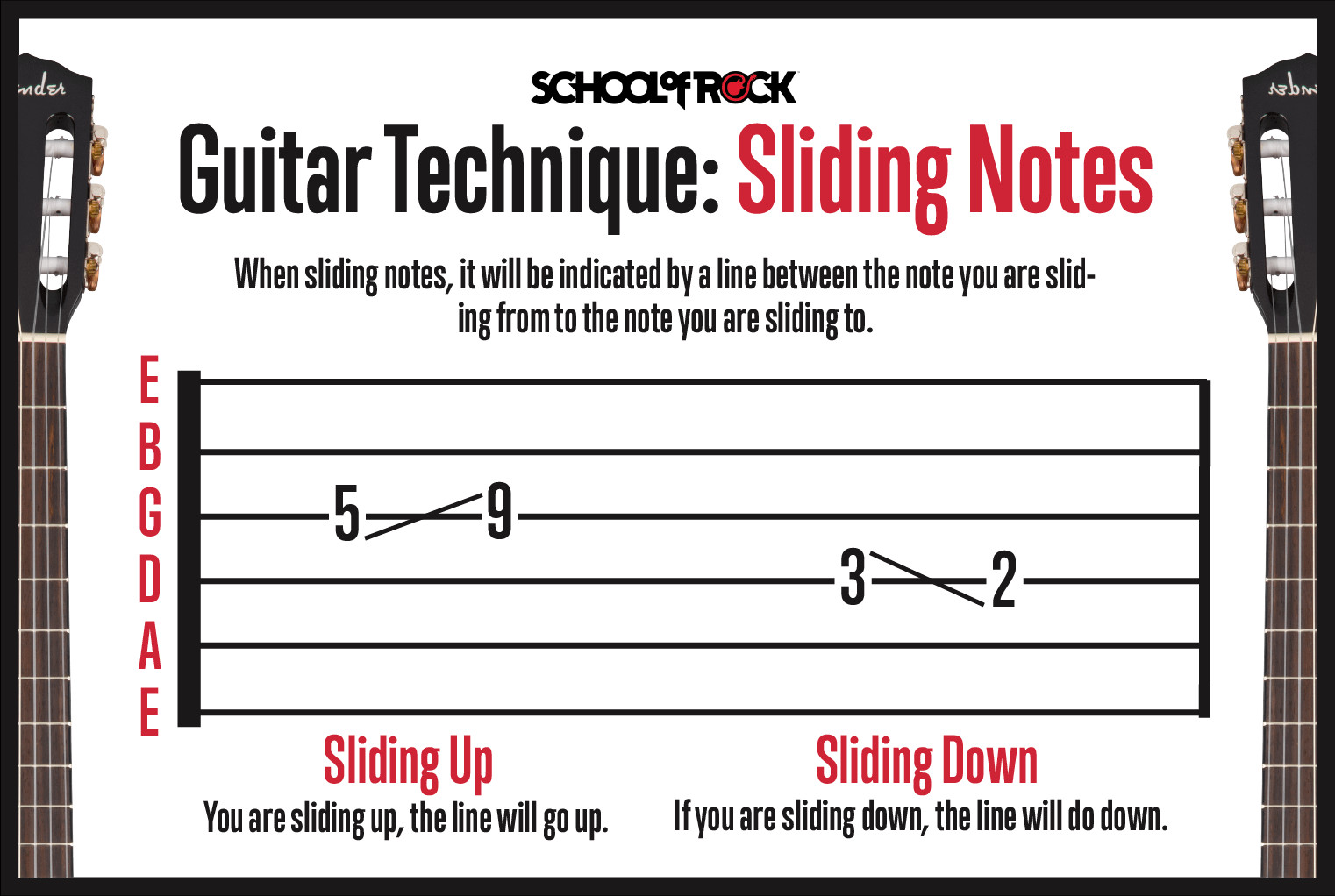 Guitar technique sliding notes
Guitar technique sliding notes
Slide Down Technique in Guitar Tabs
Similarly, a slide down is indicated by a line from the starting note to the lower target note. The line may slant slightly downwards to visually represent the descending slide.
Hammer-Ons on Guitar: Legato Playing
The hammer-on is a technique where you produce a note by “hammering” your fretting finger onto the string without picking it. You can hammer-on from an open string or a fretted note, always resulting in a higher-pitched note. In guitar tabs, hammer-ons are represented by the letter “H” and an arc connecting the initial note to the hammered-on note.
How to Perform Hammer-Ons
To perform a hammer-on, strike the string with your fretting finger with enough force to sound a clear note. This may take practice to achieve a strong, distinct tone. Hammer-ons are often easier to execute on electric guitars, especially at higher volumes. Try starting with an open low E string and hammer-on at the third fret, letting the note ring. Practice this on different strings and frets.
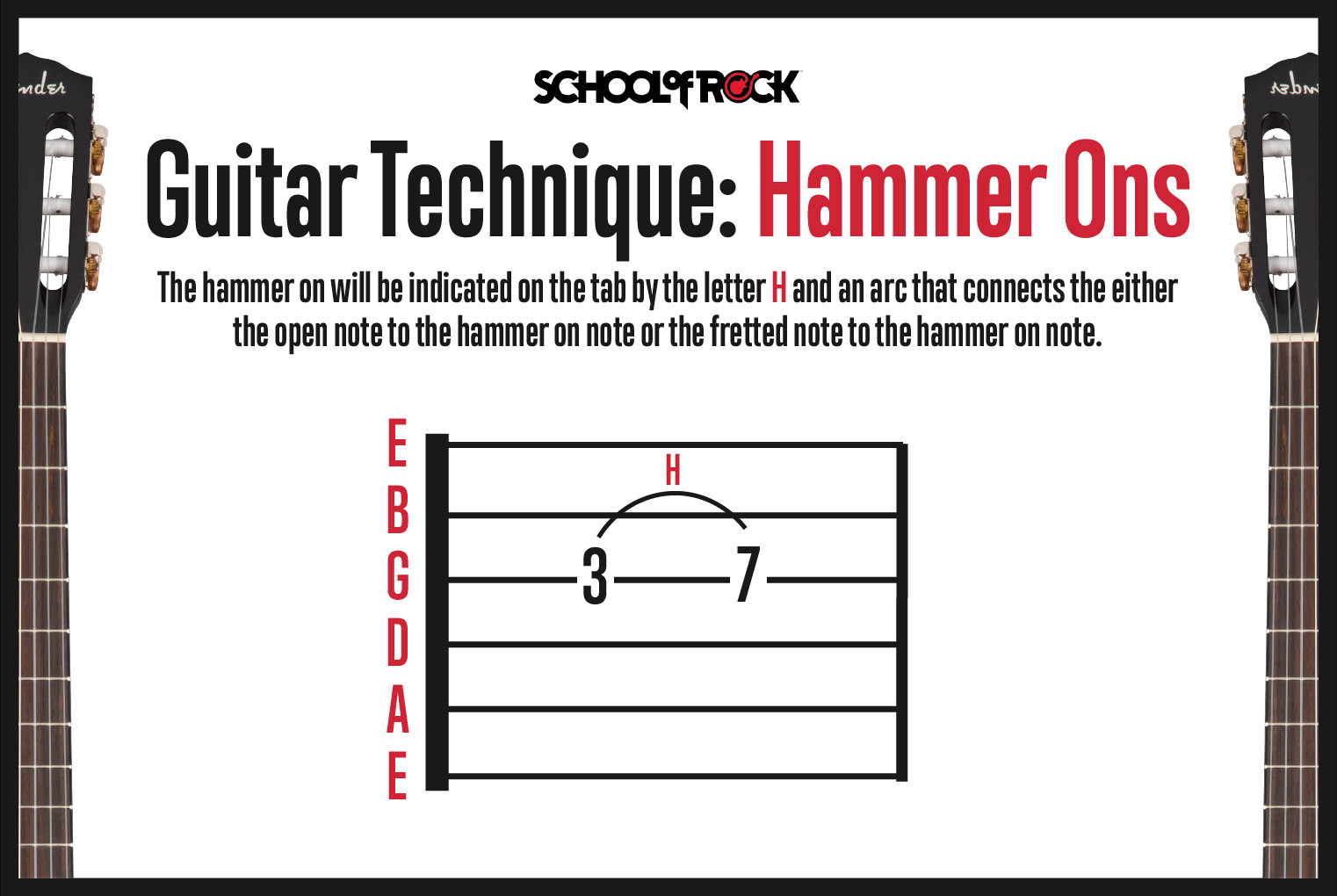 Guitar technique hammer ons
Guitar technique hammer ons
Pull-Offs on Guitar: The Reverse of Hammer-Ons
Pull-offs are the opposite of hammer-ons. You play a pull-off by plucking a fretted note off the string, allowing a lower note (either an open string or a note fretted by another finger) to sound. Pull-offs are shown in guitar tabs with the letter “P” and an arc connecting the pulled-off note to the resulting lower note.
How to Execute Pull-Offs
To perform a pull-off, fret a note and then pull your finger off the string in a sideways or downward motion, effectively plucking the string as you remove your finger. This action causes either an open string or a lower fretted note to sound. When executing pull-offs, ensure you “grab” enough of the string with your fingertip to create a clear sound.
Hammer-ons and pull-offs can be combined in alternating sequences to create trills or fast legato passages.
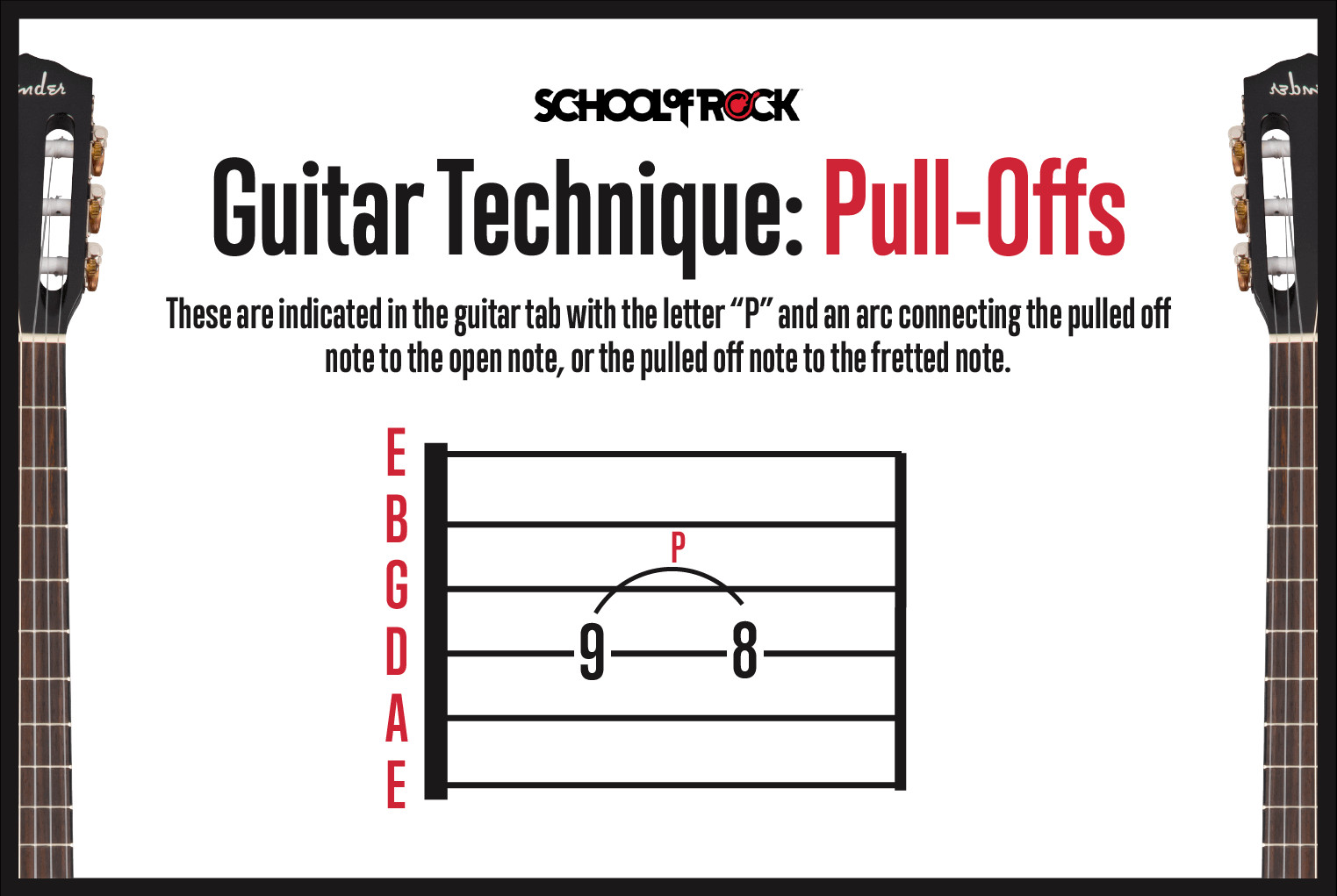 Guitar technique pull offs
Guitar technique pull offs
Vibrato on Guitar: Adding Warmth and Expression
Vibrato is a technique that adds warmth and expressiveness to notes by subtly and rapidly varying the pitch up and down around the original note, without fully bending and releasing. Vibrato is shown in guitar tabs as a zig-zag line above the staff. The length of the zig-zag line generally indicates the duration of the vibrato.
How to Create Vibrato
Vibrato is similar to bending but with a smaller pitch variation and a faster, repetitive motion. You can apply vibrato with a single finger or by using a main finger supported by others. Start practicing with a slow, smooth vibrato and gradually experiment with different speeds to achieve varied expressive effects. Like bending, vibrato is a highly personal technique, and each guitarist develops a unique vibrato style.
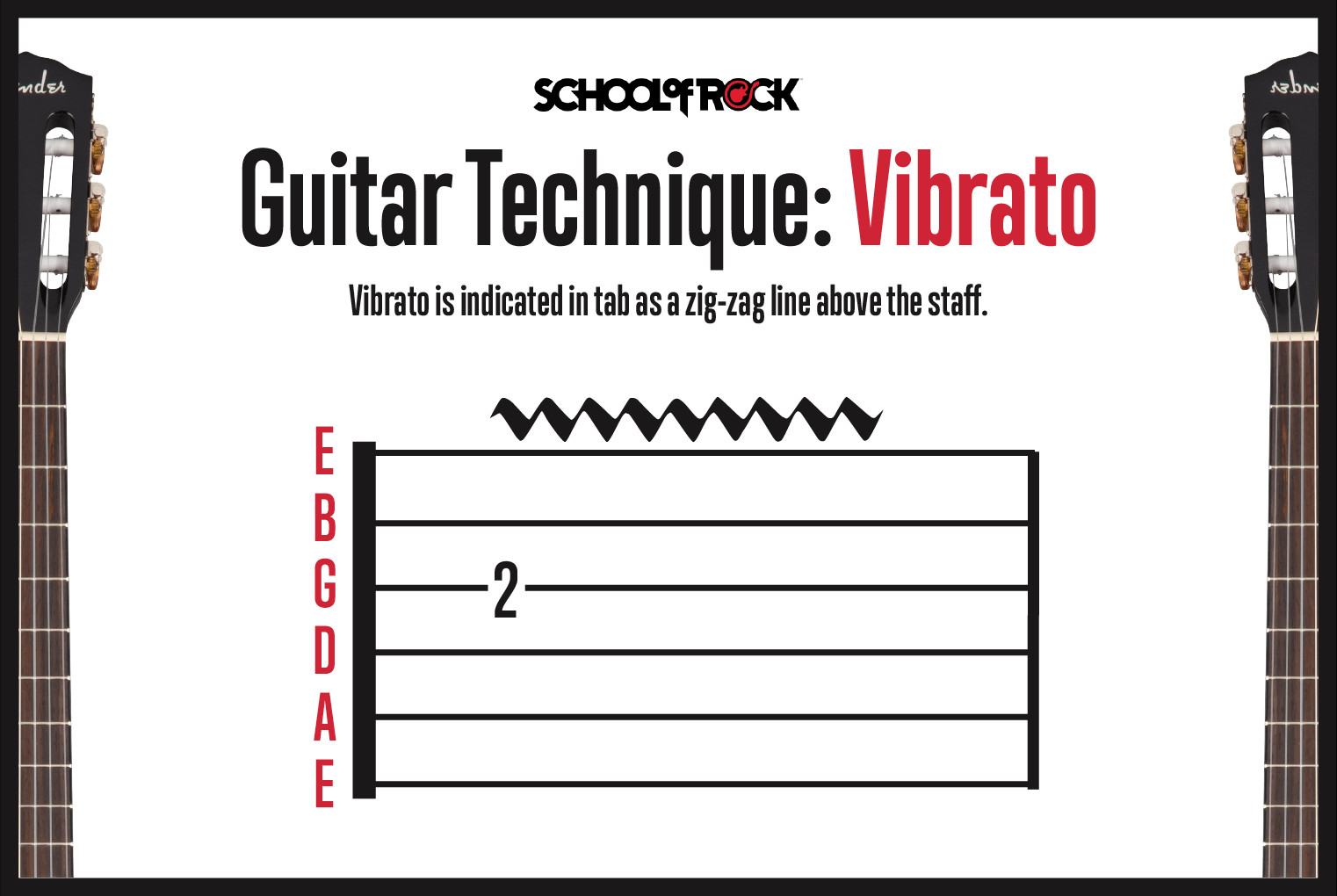 Guitar technique vibrato
Guitar technique vibrato
Tapping on Guitar: Two-Handed Fretboard Mastery
Tapping is an advanced technique that involves using both hands on the fretboard. Typically, you fret notes with your regular fretting hand and then “tap” or fret additional notes with the index finger of your picking hand. The tapping action is essentially a variation of a hammer-on performed with the picking hand. Tapping is notated in guitar tabs by a “T” above the tapped note.
How to Finger Tap
Popularized by Eddie Van Halen but with roots in classical guitar, tapping expands the guitar’s melodic and harmonic possibilities. To finger tap, fret a note with your fretting hand and then tap a higher note on the same string with your picking hand’s index finger.
Tapping is akin to a hammer-on, but uses the picking hand, allowing you to play intervals too wide to reach with just the fretting hand. Playing with distortion and higher volume often enhances the clarity and sustain of tapped notes and facilitates faster playing due to the involvement of both hands in fretting notes.
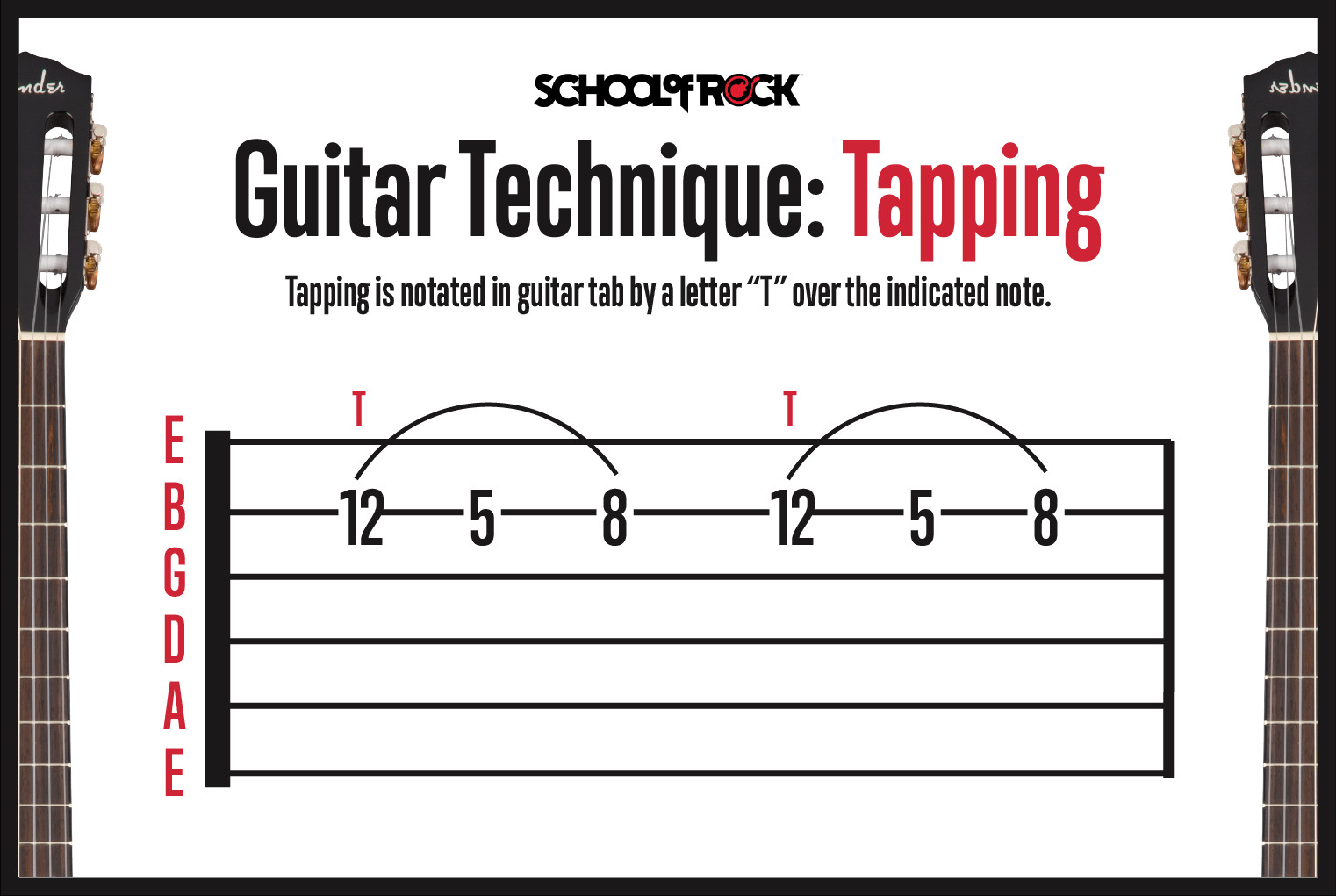 Guitar technique tapping notes
Guitar technique tapping notes
Two-Handed Tapping Technique
Two-handed tapping takes the concept further, with both hands independently tapping notes without traditional picking. This technique often involves the fretting hand tapping bass notes while the picking hand taps melody or solo lines, creating complex textures.
Strumming Guitar Notes: Rhythm and Groove
When strumming chords, two basic strumming strokes are used: downstrokes and upstrokes.
Downstrokes are played from the lower strings to the higher strings in a downward motion. In guitar tabs, downstrokes are represented by a symbol resembling a thick horizontal line with two short downward legs on either side.
Upstrokes are the opposite, played from the higher strings to the lower strings with an upward motion. Upstrokes in tabs are notated by a “V” shaped symbol.
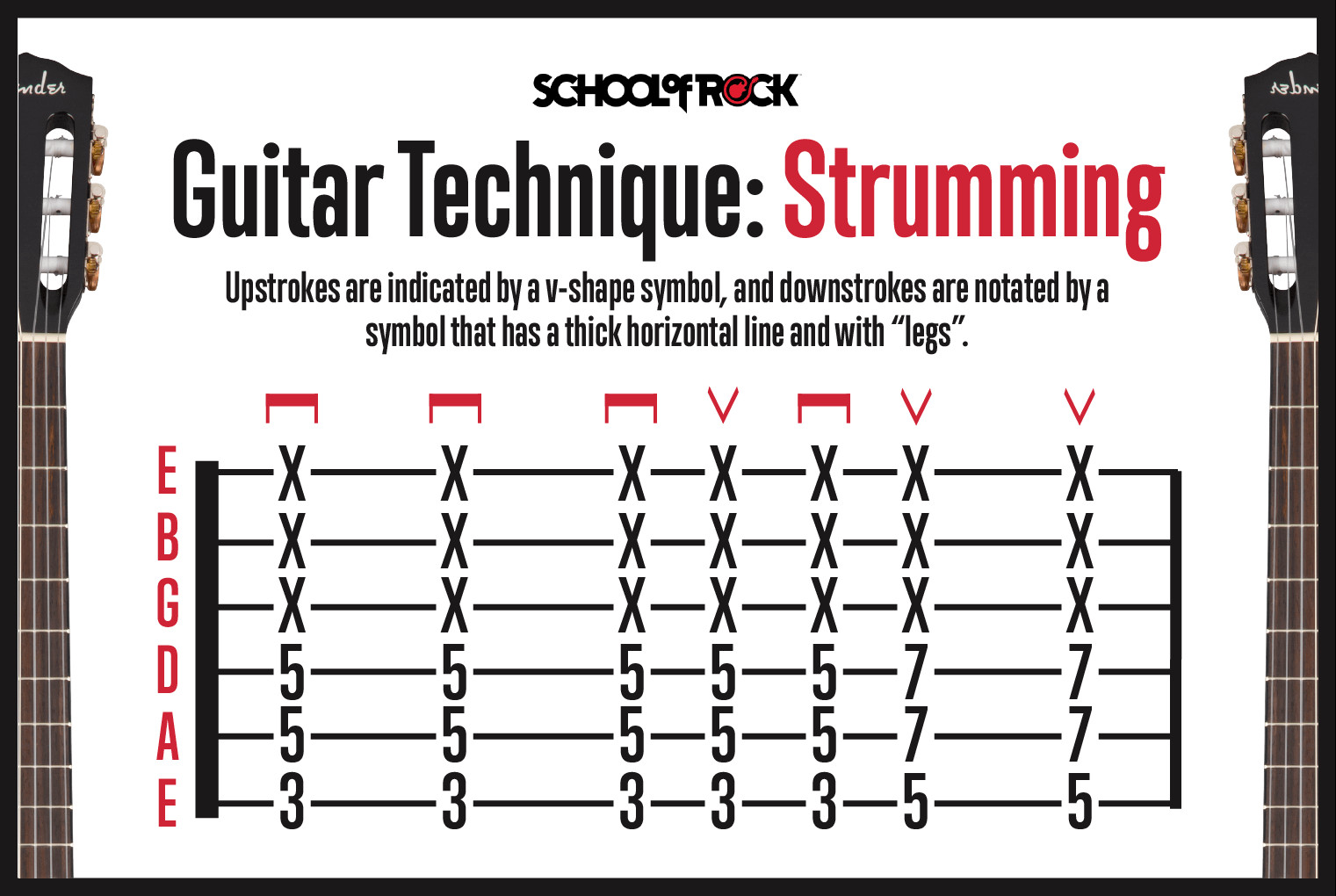 Guitar technique strumming
Guitar technique strumming
Mastering Guitar Strumming Patterns
Strumming patterns vary widely depending on the song’s rhythm. You can use a consistent downstroke or upstroke pattern, or combine them in various ways. Songs with an eighth-note rhythm are often counted as “one and two and three and four and…” Many songs use alternating downstrokes and upstrokes in an eighth-note rhythm, with downstrokes on the numbered beats (1, 2, 3, 4) and upstrokes on the “and” counts.
Downstrokes and Upstrokes for Single Notes
The same downstroke and upstroke notation applies even when playing single notes in guitar tabs. A downstroke, indicated by the horizontal bar symbol, is played with a downward pick motion. An upstroke, marked by the “V” symbol, is played with an upward pick motion.
Ready to Explore More Guitar Techniques?
Now that you’ve learned how to read guitar tabs and understand various guitar techniques, you’re well-equipped to start playing! At guitarplayers.net, we’re dedicated to helping guitarists of all levels, from beginners to advanced players, reach their full potential. From basic strumming to advanced tapping, our resources are designed to guide you in playing your favorite songs.
Eager to find guitar tabs and start playing? Whether you’re looking for easy beginner songs or challenging pieces, we’ve got you covered. Explore a vast collection of high-quality guitar tabs and sheet music to fuel your musical journey.
Thinking about a new guitar? Check out our comprehensive Guitar Buying Guide for helpful advice.

